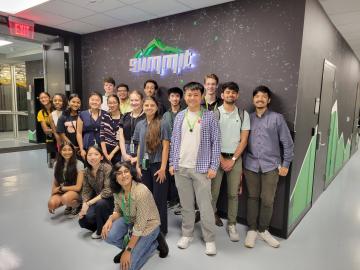ORNL's Communications team works with news media seeking information about the laboratory. Media may use the resources listed below or send questions to news@ornl.gov.
51 - 60 of 858 Results

Despite its futuristic essence, artificial intelligence has a history that can be traced through several decades, and the ORNL has played a major role. From helping to drive fundamental and applied AI research from the field’s early days focused on expert systems, computer programs that rely on AI, to more recent developments in deep learning, a form of AI that enables machines to make evidence-based decisions, the lab’s AI research spans the spectrum.

Drawing from his experience during the pandemic, Domenick Leto recognizes the need for the United States to have inexpensive, reliable capabilities to combat any type of disruption to national security, including nationwide medical emergencies. Leto and colleagues received a patent for a simple, inexpensive way to sterilize masks, plastic, and medical equipment from the COVID-19 virus.

Researchers at ORNL became the first to 3D-print large rotating steam turbine blades for generating energy in power plants.

For years, Duane Starr led workshops at ORNL to help others from across the U.S. government understand uranium processing technologies. After his retirement, Starr donated a 5-foot-tall working model, built in his garage, that demonstrates vibration harmonics, consistent with operation of a super critical gas centrifuge rotor, a valuable resource to ongoing ORNL-led workshops.

A team of computational scientists at ORNL has generated and released datasets of unprecedented scale that provide the ultraviolet visible spectral properties of over 10 million organic molecules.

On Nov. 1, about 250 employees at Oak Ridge National Laboratory gathered in person and online for Quantum on the Quad, an event designed to collect input for a quantum roadmap currently in development. This document will guide the laboratory's efforts in quantum science and technology, including strategies for expanding its expertise to all facets of the field.

Scientists from more than a dozen institutions have completed a first-of-its-kind high-resolution assessment of carbon dioxide removal potential in the United States, charting a path to achieve a net-zero greenhouse gas economy by 2050.

Research performed by a team, including scientists from ORNL and Argonne National Laboratory, has resulted in a Best Paper Award at the 19th IEEE International Conference on eScience.

This summer, ORNL welcomed more than 500 students to campus through the lab’s range of internship programs, which are offered in areas such as biology, national security and computing.

Nuclear engineering students from the United States Military Academy and United States Naval Academy are working with researchers at ORNL to complete design concepts for a nuclear propulsion rocket to go to space in 2027 as part of the Defense Advanced Research Projects Agency DRACO program.

